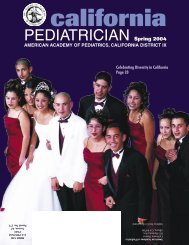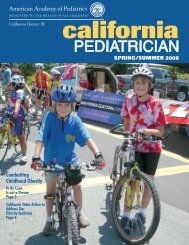PEDIATRICIAN Spring 2003 - AAP-CA
PEDIATRICIAN Spring 2003 - AAP-CA
PEDIATRICIAN Spring 2003 - AAP-CA
You also want an ePaper? Increase the reach of your titles
YUMPU automatically turns print PDFs into web optimized ePapers that Google loves.
Ten-Year Experience<br />
with Pediatric Bilateral<br />
Living Donor Lobar Lung<br />
Transplantation<br />
Marlyn S. Woo, M.D. and Vaughn A. Starnes, M.D.<br />
running out of options<br />
for this kid,” said the voice<br />
“We’re<br />
on the phone. My heart<br />
sank at that statement from an experienced<br />
physician. He had called to discuss his patient<br />
referral that had arrived at our office only a few<br />
days earlier. He had been unable to keep the<br />
ten-year old boy out of the hospital for more<br />
than a few weeks at a time, even though the<br />
child had been on almost continuous intravenous<br />
antibiotic therapy for several months. The<br />
young boy was oxygen-dependent and could<br />
not walk more than a few steps without dyspnea.<br />
He could only speak two to three words<br />
without pausing for breath. The medical team<br />
had exhausted all conventional medical and<br />
surgical options. What about lung transplantation<br />
for this dying patient?<br />
In the past, children with end-stage lung<br />
disease were not likely to survive to receive<br />
cadaveric lung transplantation unless they<br />
were referred as soon as they entered the terminal<br />
stage of their disease. Unlike heart or<br />
liver transplant candidates, cadaveric lungs<br />
available for transplant are allocated based<br />
upon the blood type, size needed, and how<br />
long the candidate has been waiting on the<br />
list. Although lung transplant candidates with<br />
idiopathic pulmonary fibrosis get three months<br />
of time added at their initial listing, cystic<br />
fibrosis and primary pulmonary hypertension<br />
patients with type O or A blood types must<br />
wait over a year (at times, five years!) before<br />
a suitable cadaveric organ becomes available.<br />
This situation puts these fragile children at a<br />
disadvantage compared to the adult lung transplant<br />
candidates (the primary adult diagnosis is<br />
chronic obstructive pulmonary disease), who<br />
comprise the majority of the cadaveric lung<br />
transplant candidates. Thus, it is not surprising<br />
that children are far more likely to die than<br />
adults while awaiting lung transplantation.<br />
The majority of pediatric lung transplant<br />
candidates have cystic fibrosis as their primary<br />
diagnosis. Hence, these patients with purulent<br />
lung disease require double lung transplantation,<br />
which also contributes to their increased<br />
delay in obtaining suitable cadaveric organs. It<br />
was in this milieu that the first human bilateral<br />
living donor lobar lung transplantation was<br />
performed. The patient was a 21-year old girl<br />
with end-stage cystic fibrosis lung disease,<br />
who had been listed for cadaveric lungs for<br />
several months. She had been hospitalized for<br />
several weeks and was not expected to survive<br />
for more than a few weeks. Her parents asked<br />
the transplant surgeon (Starnes) if they could<br />
donate portions of their lungs to save her.<br />
Dr. Starnes had already performed successful<br />
human single lobar lung transplantation. After<br />
clearance with the hospital Ethics Committee<br />
as well as the Institutional Review Board, the<br />
successful surgery took place January 1993 at<br />
USC University Hospital. A few months later<br />
(May 1993), the first successful human pediatric<br />
bilateral lobar lung transplantation took<br />
place at Childrens Hospital Los Angeles. The<br />
pediatric patient was a 13-year-old male who<br />
also had end-stage cystic fibrosis lung disease.<br />
Since those first cases, over 150 living<br />
donor bilateral lobar lung transplants have<br />
been performed throughout the world. While<br />
the majority have occurred in adult and pediatric<br />
cystic fibrosis patients, this procedure has<br />
also been successfully utilized for patients with<br />
primary pulmonary hypertension, non-transplant<br />
bronchiolitis obliterans, primary ciliary<br />
dyskinesis, and severe bronchiectasis. As of<br />
January <strong>2003</strong>, Childrens Hospital Los Angeles<br />
has performed 45 bilateral living donor lobar<br />
lung transplants in children. Although living<br />
donor lobar lung transplant recipients are generally<br />
more ill than our cadaveric candidates,<br />
there has been no significant differences in<br />
length of intubation, post-operative ICU stay,<br />
total length of hospitalization, or in perioperative<br />
mortality between these two groups.<br />
Although both cadaveric and living donor<br />
recipients receive the same triple immunosuppression<br />
therapy, pediatric living donor lobar<br />
lung transplant recipients have better one year<br />
survival and a significantly lower incidence of<br />
chronic rejection/bronchiolitis obliterans syndrome<br />
compared to cadaveric lung transplant<br />
recipients at our institution. So should living<br />
donor lobar lung transplantation be preferentially<br />
performed in all pediatric lung transplant<br />
candidates? There are several obstacles to performing<br />
living donor lobar lung transplantation<br />
in all pediatric candidates.<br />
Living donor lobar lung transplant candidates<br />
must meet the same criteria as those<br />
being considered for cadaveric organs (Table<br />
1). They must be healthy enough to survive<br />
major surgery. Importantly, they must also<br />
have at least two healthy donors acceptable<br />
to the Transplant Team (Table 2). Our Center,<br />
as well as the other United States Transplant<br />
Centers who have performed more than living<br />
donor lobar procedures, do not accept living<br />
donor lobar candidates who have no emotional<br />
attachment to the proposed recipient or family;<br />
solicited or “stranger” volunteers; nor donor<br />
candidates who have been coerced (selling<br />
organs). Interestingly, over half of the living<br />
lobar lung transplants have utilized lobes<br />
donated by healthy adults who are not related<br />
to the recipients.<br />
CONTINUED ON PAGE 20<br />
<strong>CA</strong>LIFORNIA <strong>PEDIATRICIAN</strong> — SPRING <strong>2003</strong>/ 13








